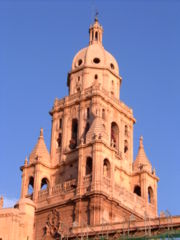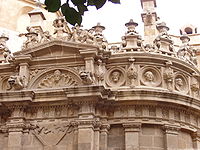
Cathedral of Murcia
Encyclopedia
The Cathedral Church of Saint Mary in Murcia (Spanish: Iglesia Catedral de Santa María en Murcia), commonly called the Cathedral of Murcia, is a church the city of Murcia
, Spain
. It is the only cathedral
in use in the Roman Catholic Diocese of Cartagena in Spain.
The heart and the entrails of the king Alfonso X the Wise are buried under the main altar of the cathedral, as he indicated in his testament, as a gift and proof of his love to Murcia and in thanks to the fidelity that the city showed to him.
As previously stated, the artistic style of the building is very varied because it was finished in the 18th century. Its interior is Gothic
; the facade is Baroque
and it was made by the Valencian architect and sculptor Jaume Bort i Meliá.
 The bell tower
The bell tower
, built between 1521 and 1791, stands 90 meters tall (95 meters with the weathervane). Is the tallest campanile in Spain. It ascends in five stages of different widths. The tower also combines a melange of styles.
The bells have also served to warn the population about the catastrophic floods of the Segura River, wars, celebrations, and festivities.
The oldest bell (14th century), la Campana Mora (the moor bell), is kept in the Museum of the Cathedral of Murcia.
. It is made up of three nave
s with an apse
and twenty-three chapel
s. The chapels are dedicated to the patron saints of the labor unions and to the burials of the bishops and nobles that fomented or collaborated with the construction of the cathedral. Some chapels can be emphasized:
The Plateresque chairs of the choir
, post-choir, and the portal of the sacristy
, are significant.

Murcia
-History:It is widely believed that Murcia's name is derived from the Latin words of Myrtea or Murtea, meaning land of Myrtle , although it may also be a derivation of the word Murtia, which would mean Murtius Village...
, Spain
Spain
Spain , officially the Kingdom of Spain languages]] under the European Charter for Regional or Minority Languages. In each of these, Spain's official name is as follows:;;;;;;), is a country and member state of the European Union located in southwestern Europe on the Iberian Peninsula...
. It is the only cathedral
Cathedral
A cathedral is a Christian church that contains the seat of a bishop...
in use in the Roman Catholic Diocese of Cartagena in Spain.
History
When the Christian king Jaime I the Conqueror conquered the city, in spite of the existing pact with the Muslims of the city that prevented destroying any mosque, the king Jaime I took the Great Mosque or Aljamía to consecrate it to the Virgin Mary, since he had the custom to offer a mass to Our Lady whenever he conquered a village. The cimentation of the cathedral begun in the 13th century, in the same place where the great mosque stood. In 1385 the laying of foundations began and in 1388 the first stone was laid. But it was not until 1394 that the construction began, which would be finished in October 1467. Nevertheless, the cathedral continued to grow until the 18th century, which means that the cathedral is made of a variety of artistic styles.The heart and the entrails of the king Alfonso X the Wise are buried under the main altar of the cathedral, as he indicated in his testament, as a gift and proof of his love to Murcia and in thanks to the fidelity that the city showed to him.
As previously stated, the artistic style of the building is very varied because it was finished in the 18th century. Its interior is Gothic
Gothic architecture
Gothic architecture is a style of architecture that flourished during the high and late medieval period. It evolved from Romanesque architecture and was succeeded by Renaissance architecture....
; the facade is Baroque
Baroque
The Baroque is a period and the style that used exaggerated motion and clear, easily interpreted detail to produce drama, tension, exuberance, and grandeur in sculpture, painting, literature, dance, and music...
and it was made by the Valencian architect and sculptor Jaume Bort i Meliá.
The Bell Tower

Bell tower
A bell tower is a tower which contains one or more bells, or which is designed to hold bells, even if it has none. In the European tradition, such a tower most commonly serves as part of a church and contains church bells. When attached to a city hall or other civic building, especially in...
, built between 1521 and 1791, stands 90 meters tall (95 meters with the weathervane). Is the tallest campanile in Spain. It ascends in five stages of different widths. The tower also combines a melange of styles.
- The first stage, made by Francisco and Jacobo Florentino, has a square plant with Renaissance style and ornamentation influenced by the Hispanic PlateresquePlateresquePlateresque, meaning "in the manner of a silversmith" , was an artistic movement, especially architectural, traditionally held to be exclusive to Spain and its territories, which appeared between the late Gothic and early Renaissance in the late 15th century, and spread over the next two centuries...
. - The second body, made by Jerónimo Quijano, has the same style but it is more purist.
- The third floor, with Baroque style, has the body with Rococó style and the cupola, drawn up by Ventura RodríguezVentura RodríguezVentura Rodríguez Tizón was a Spanish architect and artist. Born at Ciempozuelos, Rodríguez was the son of a bricklayer. In 1727, he collaborated with his father in the work at the Royal Palace of Aranjuez.-Major works:...
, with Neoclassic style. - In the fourth floor, there are four conjuratories. Located in each corner, special ceremonies were conducted in them by priests to ward off storms by means of the Lignum Crucis.
Bells
There are twenty-five bells, all of the 17th century and the 18th century. Each has its own name. Among them are:- The Bell of the Spells
- La Catalana
- The Bell of Prayer
- La Fuensanta
- The Conception
- La Segundilla
- The greater or Agueda-Martillo, which is the main bell
The bells have also served to warn the population about the catastrophic floods of the Segura River, wars, celebrations, and festivities.
The oldest bell (14th century), la Campana Mora (the moor bell), is kept in the Museum of the Cathedral of Murcia.
Interior
The interior is mainly GothicGothic architecture
Gothic architecture is a style of architecture that flourished during the high and late medieval period. It evolved from Romanesque architecture and was succeeded by Renaissance architecture....
. It is made up of three nave
Nave
In Romanesque and Gothic Christian abbey, cathedral basilica and church architecture, the nave is the central approach to the high altar, the main body of the church. "Nave" was probably suggested by the keel shape of its vaulting...
s with an apse
Apse
In architecture, the apse is a semicircular recess covered with a hemispherical vault or semi-dome...
and twenty-three chapel
Chapel
A chapel is a building used by Christians as a place of fellowship and worship. It may be part of a larger structure or complex, such as a church, college, hospital, palace, prison or funeral home, located on board a military or commercial ship, or it may be an entirely free-standing building,...
s. The chapels are dedicated to the patron saints of the labor unions and to the burials of the bishops and nobles that fomented or collaborated with the construction of the cathedral. Some chapels can be emphasized:
- The Chapel of the Apse or the Vélez Chapel: it has Flaming Gothic style, with a cupola of stars with ten points.
- The Chapel of Junterones: it is one of the great works of the Spanish Renaissance.
- The Chapel of the Immaculate: it is Baroque in style.
The Plateresque chairs of the choir
Choir
A choir, chorale or chorus is a musical ensemble of singers. Choral music, in turn, is the music written specifically for such an ensemble to perform.A body of singers who perform together as a group is called a choir or chorus...
, post-choir, and the portal of the sacristy
Sacristy
A sacristy is a room for keeping vestments and other church furnishings, sacred vessels, and parish records.The sacristy is usually located inside the church, but in some cases it is an annex or separate building...
, are significant.
Exterior

- Door of Apostols: Constructed in 1488 by Diego Sánchez de Almazán. It has Gothic style. At the jambs (sides) of the door, the sculptures of the four apostles are shown. It also has a shield which honors the queen Isabel the Catholic.
- Chapel of the Marquess of Vélez: Its plan is polygonal and adorned with the shields of the Chacones and the Fajardos.
- Door of the Chains: Made of two bodies (the inferior from the 16th century and the superior from the 18th century), with reliefs of the brothers San Leandro, San Isidoro, and San Fulgencio.
- Main Facade: It has Baroque style. The main facade has an exceptional beauty and it is unique. It was built under the initiative of the Cabildo, with the help of Cardinal Belluga, and it was made by Jaime Bort.
- Exaltation of the Virgin Mary
External links
- The Cathedral and a Picture Gallery from the Murcia City Official Tourism Site.
- Photos Diocese of Cartagena

